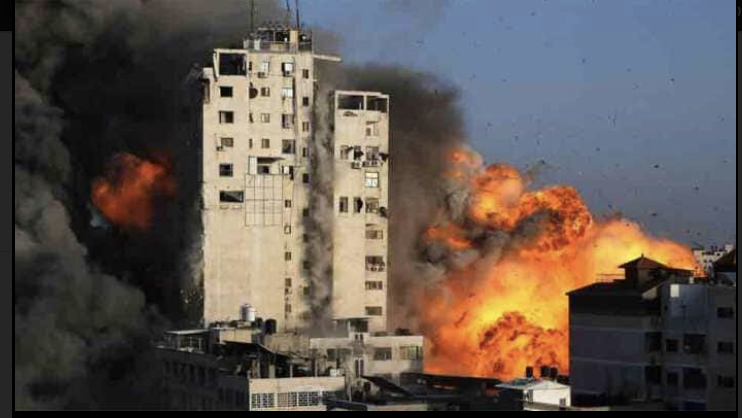 The 11-day bloody Israel-Hamas Conflict seems to have ended after an Egyptian brokered ceasefire came into effect on May 21, leaving behind tales of death and destruction. Hamas fired more than 4000 rockets on Israeli towns and settlements from Gaza killing 12 people, mostly civilians including an Indian nurse working in Israel. 90% of these rockets were intercepted by the anti-missile defence systems of Israel, minimizing causalities yet forcing Israeli citizens to rush to a nearby shelters once the missile-raid siren was blown disrupting the routine life.
The 11-day bloody Israel-Hamas Conflict seems to have ended after an Egyptian brokered ceasefire came into effect on May 21, leaving behind tales of death and destruction. Hamas fired more than 4000 rockets on Israeli towns and settlements from Gaza killing 12 people, mostly civilians including an Indian nurse working in Israel. 90% of these rockets were intercepted by the anti-missile defence systems of Israel, minimizing causalities yet forcing Israeli citizens to rush to a nearby shelters once the missile-raid siren was blown disrupting the routine life.
Israel which does not believe in a graduated response went after the Hamas, a terrorist group, with all its might. The retaliatory Israeli aerial and artillery response killed more than 230 people in Gaza which included many Hamas terrorists and their leaders. The bombing also resulted in destruction of 1000 residential units and five towers, one of them reportedly was being used as Headquarters of Hamas. It also leveled three mosques, damaged 17 hospitals, clinics and dozens of schools. The only Covid-19 testing lab in Gaza was erased to the ground. The civic amenities like water, electricity and sewer service to much of the enclave were cut off. Tunnels referred to as the ‘Metro tunnels’ used by the Hamas cadre as a shelter and hideout were specifically targeted by the Israeli Air force. Tens of thousands of residents across Gaza were displaced from their homes with as many as 75,000 seeking shelter in United Nations-run schools. Death and destruction galore in the tiny Gaza strip in a span of ten days!
The trigger for the Hamas rocket offensive wasIsrael’s policing of the Al-Aqsa Mosque compound in Jerusalem during the holy month of Ramadan andthe forced evictions of six Palestinian families from the Sheikh Jarrah neighborhood in East Jerusalem by the Jewish settlers. Hamas is an acronym for Harakatal-Muqawama al-Islamiyya. It is an Islamic resistance movement which has been designated as a terror organization by Israel, USA and many European countries. Hamas is unlike other global jihadi terror organizations. It’s a main-streamed terror outfit that is virtually ruling the Gaza strip since 2007. Hamas won an overwhelming victory in Palestinian parliamentary elections held in January 2006. It triggered a struggle for primacy with its arch rival the Fatah movement led by Mahmoud Abbas.
While Fatah strengthened its hold over West Bank, Hamas emerged as the main power in Gaza, which was captured by the Israeli Defence Forces during the famous 1967 Six-Day War and vacated by it in September 2005. Since June 2007, two rival governments have emerged in Palestinian territory: Hamas in Gaza and Abbas led Palestinian Authority in the West Bank. Hamas actually came into being towards the end of 1980s led by Sunni-Islamic fundamentalists and was able to fill the political space left by Yaseer Arafat’s Palestine Liberation Organisation (PLO) which moved towards the “path of a peaceful settlement.” Hamas believes that there is no solution to the Palestinian problem other thanthe Jihad. Hamas and Israel have been in a state of conflict since then. Hamas also enjoys the support of Lebanon based Hezbollah and Iran.
While Gaza is under the firm control of the Hamas, it continues to reel under the blockade imposed by Israel and Egypt since 2006 leading to deplorable living conditions since the blockade restricts the freedom of movement and goods. Gaza under the Hamas has, per se, become the seat of Islamic resistance movement against Israel.
Life for the Palestinians is no better in other areas where they face a deeply fragmented political authority. While the Abbas led Palestinian authority controls the urban enclaves in the West Bank, the other populated areas have a mixed regime. The Israelis enjoy direct military control in about 60percent of the territory where Israelis also live. Thus, to say that only Jews live in Israel and only Palestinians inhibit their territory is a misnomer.
The control of West Bank and Gaza by Israel has provided this tiny nation defensive control and resources in event of an Arab attack. Resultantly, it has also brought a large Arab population under Israeli authority.
It is the mixed population that has added a new dimension to the current conflict. Israel for the first time during a conflict had to face not only theexternal enemy but also the internal clashes and mob violence led by young Arabs on the streets of Israeli towns- Lod, Ramallah, Acre and Haifa. This new challenge which included rampaging Arab youths setting cars on fire, damaging property, torching synagogues and specifically targeting Jewish houses and property took the Israeli government by surprise. Israel will have to vector internal security and maintenance of law and order in its future battle plans.
Interestingly, while the current points of frictions were located in the West Bank, it was the Hamas which challenged the might of Israel and not the Palestinian Authority government led by Abbas. There is a virtual power struggle between the two with Hamas trying to portray itself as the protector of holy Muslim sites in Jerusalem and the virtual leader of the Palestinians. Israel, however, dismisses Hamas as a terror outfit, an unrepentant enemy least interested in peace with Israel. At the peak of the 11-day conflict, the Israeli Prime Minister Netanyahu tweeted, “Only 70 years ago! Jews were taken to slaughter like sheep. Sixty years ago, seven Arab countries together declared war on a small Jewish state, only a few hours after its creation. We were 650,000 Jews against the millions in the Arab world. There was no strong Israeli Defence Forces. But we won. Who is Hamas to scare me? You make me laugh.” Israel rightfully claims to have badly eroded the warfighting capability of the Hamas despite liberal support from Iran. But Hamas is not completely done with nor does the current ceasefire kindle any hope of the lasting peace in the area since the major causes of the Israel- Palestine conflict still remain unresolved. For how long the ceasefire holds is a million-dollar question?
India under PM Modi is following a ‘de hyphenation policy’ with regards to relations with Israel and Palestine. He was the first Indian Prime Minister to visit Palestine in February 2018 and was conferred with the highest civilian award of the land. Officially, India has condemned the Hamas rocket attacks against Israeli settlements and at the same time reiterated its long-standing policy of advocating a two-state formula. However, there was a groundswell of support among the large section of Indians for the Israel’s war against the terrorists. Indians support Israel’s sovereignty and condemn the rocket attacks against it by the non-state actors since the Hamas does not represent Palestine. There were pro-Palestine protests also mainly by the Muslims due to their reverence for the Al Aqsa Mosque.
India also faces threat from non-state actors apart from its traditional foes. Thus, we can draw a few lessons from the current conflict in the Middle-East. These are enumerated in the following paragraphs.
Power begets Respect. Israel has proved it. Very few countries in the world are prepared to “condemn” Israel. Due to its military prowess, Israel is the undisputed power in the region that enjoys international support. While the Palestinian Cause invites sympathy yet no nation openly criticized Israel for its retaliatory artillery and aerial strikes in the Gaza strip. Global community knows that Israel would not succumb to any pressures and may go to any extent to defend its sovereignty. It may concede on the negotiating table but never due to fear of the sword. India also needs to transform herself from a military force to a military power.
International Relations are based on National interests and not Ideologies. All neighbouringcountries are mostly Islamic but divided in their response against Israel. Iran and Hezbollah primarily Shia are the biggest supporters of Hamas, a Sunni Islamic resistance movement. Egypt, Saudi Arabia and many other Islamic countries are in favour of an Arab-Israel alliance to counter the rival Chinese promoted Turkey-Iran-Pakistan alliance. The US facilitated “the Abrahams Accords”, resulting in a series of peace agreements between Israel and Arab Islamic nations like the UAE, Bahrain, Morocco and Sudan have proved a game-changer in the region. The traditional monarchies of the region find the growing Palestinian nationalism as a threat to their core national interest. They also view Israel as a useful ally in the region to counter Iranian and Sunni extremism. India needs to take a call, in favour of Israel, since it has stood with us like a solid rock in the hour of crisis and whenever needed.
Zero Tolerance for Terror. There is global condemnation of terror. India needs to demonstrate its capability of zero tolerance against terror by razing to ground any terror training camp or terror launch pad as and when its surfaces. Also, it needs to revisit its policy of graded response while dealing with non-state actors operating from foreign soils.
Anti-Missile Defence System. The advent of suicide drones, cheap rockets and sophisticated missile systems has changed the contour of modern warfare. India needs to deploy and operationalize its anti-missile defence systems and restructure its over allair defence strategy. Our missile defence shield has to be impregnable. India also needs to invest heavily in emerging technologies and include weapon systems based on these technologies in the arsenal of our Armed Forces.
Air Superiority Deterrence. In view of the threats faced by it, India needs to maintain air superiority deterrence in the region at all costs. We not only need to build the squadron strength to 42 but also add various force multipliers like AWACS and stealth bombers to ensure our undisputed air superiority.
Aatam Nirbharta. To become a military power, we have to relentlessly pursue our Aatam Nirbharprogramme with strict time-lines. DRDO and the indigenous industry have a major role to play along with unwavering support from the Armed Forces. While doing all this we have to remain cautious of rapid technological shifts to ensure that our newly developed systems are not on the verge of obsolescence at the time of introduction. We also need to focus on anti-drone strategy to ensure defence against suicide drones which attack battlefield air defence systems first to gain and maintain low-altitude airspace before attacking other ground-based systems like tanks, artillery and logistics installations.
The current stand-off has shown that how non-state actors with the backing of enemy nations can cause havoc and challenge a military power. It’s no more in the realm of scenario-building but a reality.





Very good article particularly on the need to become military power not just a military power. You do not gain respect if you are not a military power. The mindset has to change within the Hindutva approach of inclusiveness.
Enlightening article clearly defining relevant geographical aspects and the etymology of the resistance movement in Gaza – Hamas. Interesting to read the Hamas Israel conflict and its lessons for India by way of the importance of ATMANIRBHAR BHARAT. A must read for the West Asia watchers.
It’s not a bad article, but there’s no need to post it twice.
One interesting little fact: the Israeli government assisted Hamas in the 1980s (one American ambassador to Saudi Arabia went as far as to declare that ‘Israel created Hamas’ – see the chapter ‘Israel’s Islamists’ in ‘Devil’s Game’ by Robert Dreyfuss) – not because of any sympathy for Islam, but because they saw it as an opportunity to undermine the secular resistance – Fatah.
The ploy succeeded: the Palestinians are divided between the two, and their cause, slowly but certainly, is losing support among non-Muslims (noticeably in India) as it becomes associated with Islamic terrorism.
There is really only one lesson in this. That if India continues to practice Nehruvian Gandhistry or “Tolerance” as Obama abused Indian hospitality to advise Modi, India will sink into the same quagmire of Allahu Akbar. Between Bush and Obama Europe has been set on the same trajectory. Sweden is well on its way to becoming an India as prelude to becoming a Pakistan. The only solution is to ban Quran and Hadith and declare Islam an illegitimate religion owing to its atavistic precepts and modus operandi.